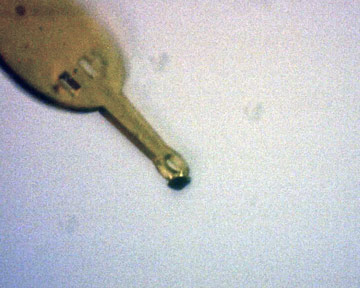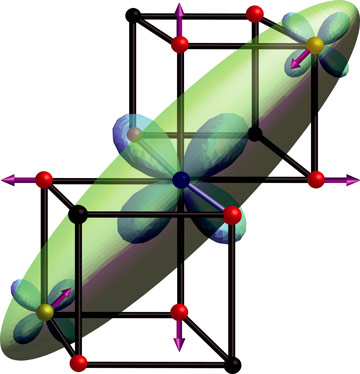- Home
- News
- General News
- Landmark discovery...
Landmark discovery has magnetic appeal for scientists
19-12-2011
A fundamental problem that has puzzled generations of scientists has finally been solved after more than 70 years. An international team discovered how a subtle electronic effect in magnetite – the most magnetic of all naturally occurring minerals – causes a dramatic change to how this material conducts electricity at very low temperatures. The discovery gives new insight into the very mineral in which mankind discovered magnetism, and it may enable magnetite and similar materials to be exploited in new ways. The results are published today in Nature.
Share
Jointly published by The University of Edinburgh and the ESRF.
The research team was led by Paul Attfield of the University of Edinburgh’s Centre for Science at Extreme Conditions and comprised also a scientist from the European Synchrotron Radiation Facility (ESRF) in Grenoble, France, where the experiments were conducted.
The magnetic properties of magnetite have been known for more than 2000 years and gave rise to the original concepts of magnets and magnetism. The mineral has also formed the basis for decades of research into magnetic recording and information storage materials.
Magnetite is made of the same chemical elements as rust – iron and oxygen – but in different proportions: three parts of iron for four parts of oxygen. It is called a lodestone when magnetised by the Earth’s magnetic field and was used to build early forms of the magnetic compass. When magnetite crystallises from hot iron-rich magma rising from deep inside the Earth, it conserves the direction of the Earth’s magnetic field, which was key to the discovery that this field reversed direction several times over Earth’s history. Tiny crystals of magnetite are also found in the brains of insects and even pigeons and thought to play a role in their ability to find the way back home over long distances.
In 1939, Dutch scientist Evert Verwey discovered that the electrical conductivity of magnetite decreases abruptly and dramatically at low temperatures (125 Kelvin which is about minus 150 degrees Celsius): the metallic mineral turns into an insulator. Despite many efforts, until now the reason for this transition has been debated and remained controversial.
When the team of scientists fired an intense X-ray beam at a tiny crystal of magnetite at very low temperatures, they were able to understand the subtle rearrangement of the mineral’s chemical structure. Electrons are being trapped within groups of three iron atoms where they can no longer transport an electrical current.
“Our main challenge was to obtain a perfect crystal, which meant using one that was tiny, just half the diameter of a human hair. Then we needed to observe subtle changes in this microscopic sample as we lowered the temperature. In Europe, this is only possible at the ESRF, thanks to the extremely high energy of its synchrotron X-rays”, says Jon Wright of the ESRF.
 |
A photo of the microscopic magnetite crystal used for the experiment, measuring just 40 micrometres across, at the tip of the kapton sample holder. |
At low temperatures, a magnetite crystal shows a complex pattern of movements of many iron and oxygen atoms. Fewer than 1% of the electrons in the material are involved in the transition to the insulating state, making the changes hard to observe. It took more than a decade of hard work for Paul Attfield and his team to finally work out that three iron atoms collectively trap an electron between them.
“We have solved a fundamental problem in understanding the original magnetic material, upon which everything we know about magnetism is built. This vital insight into how magnetite is constructed and how it behaves will help in the development of future electronic and magnetic technologies,” concludes Paul Attfield.
Reference
Charge-order and three-site distortions in the Verwey structure of magnetite, M. Senn, J. Wright and P. Attfield, Nature 481, 173–176 (2011).
Top image: The three authors (Paul Attfield, Mark Senn and Jonathan Wright, from left to right) in front of a couple of magnetite crystals (Credit: Ana Wright).




